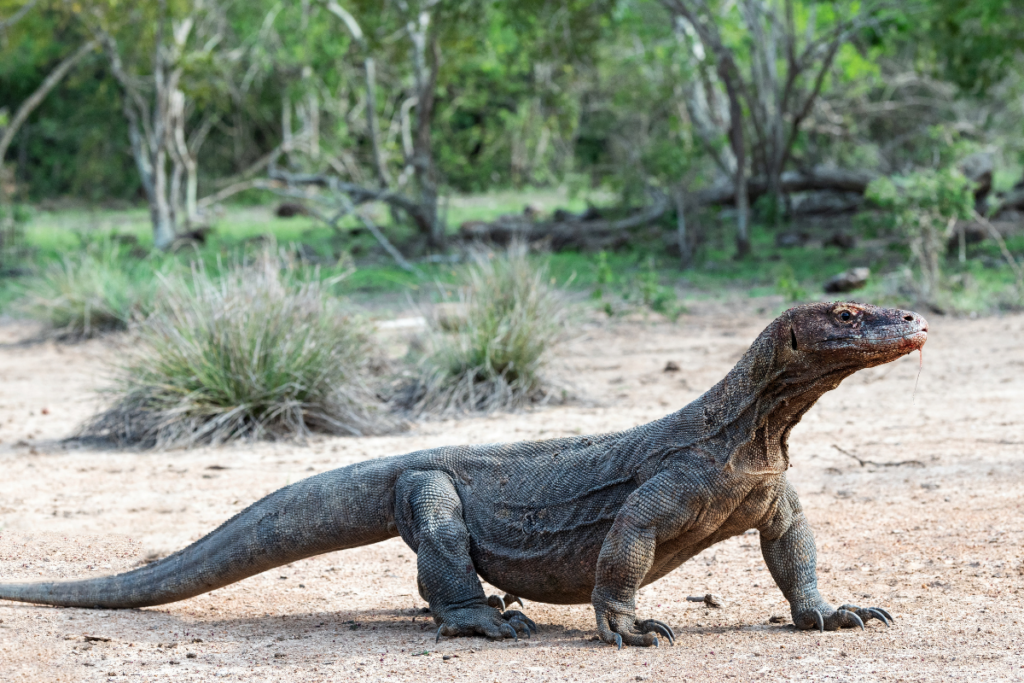The Komodo dragon (Varanus komodoensis) stands as a symbol of Indonesia’s natural heritage, a colossal lizard found only in the Indonesian islands of Komodo, Rinca, Flores, Gili Motang, and Padar.
These awe-inspiring creatures, which can grow up to ten feet long and weigh over 150 pounds, have become a significant attraction for eco-tourists and wildlife enthusiasts from around the world.
However, the increasing influx of tourists poses a potential threat to the fragile ecosystems that support these magnificent reptiles.
Thus, implementing strategies for sustainable tourism is imperative to ensure the conservation of Komodo dragons and their habitats.
Understanding the Komodo Dragon

Before delving into sustainable tourism strategies, it is crucial to understand the Komodo dragon’s ecological significance and the threats they face.
As apex predators, Komodo dragons play a vital role in maintaining the balance of their ecosystem.
They primarily feed on large prey such as deer and wild boar, regulating the population of these species and thus preventing overgrazing and habitat degradation.
However, the Komodo dragon’s limited distribution makes it particularly vulnerable to threats such as habitat destruction, climate change, and human disturbances.
The Komodo National Park, established in 1980, serves as the primary sanctuary for these creatures, but even this protected area is not immune to the pressures of increasing tourism.
The Challenges of Tourism

Tourism brings both opportunities and challenges to the regions inhabited by Komodo dragons.
Economically, it provides income and employment opportunities for local communities, fostering development and raising awareness about the importance of conservation.
However, the downside includes habitat disruption, pollution, and the potential for negative human-wildlife interactions.
Habitat Disruption: The construction of tourist facilities, trails, and other infrastructure can lead to habitat fragmentation and degradation.
Komodo dragons require large territories to hunt and mate, and any disturbance to their habitat can adversely affect their behavior and population dynamics.
Pollution: Increased tourist activity can lead to higher levels of waste and pollution.
Plastic waste, in particular, poses a significant threat to wildlife, including Komodo dragons, who might ingest it accidentally.
Human-Wildlife Interactions: Tourists often seek close encounters with Komodo dragons, leading to potentially dangerous situations for both humans and animals.
Such interactions can cause stress to the dragons and may result in aggressive behavior.
Strategies for Sustainable Tourism
To mitigate these challenges and ensure the long-term survival of Komodo dragons, several sustainable tourism strategies can be implemented:
1. Controlled Visitor Access
Limiting the number of visitors to Komodo National Park is essential to minimize the impact on the environment.
Implementing a quota system can help regulate the flow of tourists, ensuring that the park does not exceed its carrying capacity.
Additionally, designated viewing areas and trails can prevent habitat trampling and reduce disturbances to the dragons.
2. Eco-Friendly Infrastructure
Developing eco-friendly infrastructure is crucial for minimizing the ecological footprint of tourism.
This includes using sustainable materials for construction, employing renewable energy sources, and implementing waste management systems.
For example, solar-powered facilities and composting toilets can significantly reduce the environmental impact.
3. Community Involvement and Education
Engaging local communities in tourism activities can enhance conservation efforts while providing economic benefits.
Training local guides and involving them in conservation education programs can foster a sense of stewardship among residents.
Educational initiatives for tourists can also raise awareness about the importance of respecting wildlife and following park regulations.
4. Research and Monitoring
Continuous research and monitoring are vital for understanding the impact of tourism on Komodo dragons and their habitat.
Collaborating with scientific institutions to conduct regular surveys and studies can provide valuable data for informed decision-making.
Monitoring visitor behavior and enforcing rules strictly can also ensure that tourism activities remain sustainable.
5. Promoting Off-Peak Tourism
Encouraging tourists to visit during off-peak seasons can help distribute the environmental load more evenly throughout the year.
This approach can prevent overcrowding during peak times and reduce stress on the habitat and wildlife.
6. Implementing Strict Guidelines and Regulations
Establishing and enforcing strict guidelines and regulations for tourists is essential to minimize human-wildlife conflicts.
These guidelines should include maintaining a safe distance from the dragons, prohibiting feeding or touching them, and following designated paths.
Heavy fines and penalties for non-compliance can deter irresponsible behavior.
Case Study: Successful Sustainable Tourism Practices
Several regions around the world have successfully implemented sustainable tourism practices that can serve as models for Komodo National Park.
Galápagos Islands, Ecuador: The Galápagos Islands have a well-regulated tourism model that limits the number of visitors and strictly controls human activities.
The use of certified guides, well-defined visitor routes, and stringent conservation regulations has helped preserve the unique biodiversity of the islands.
Bwindi Impenetrable National Park, Uganda: This park, home to endangered mountain gorillas, has successfully integrated community involvement in its tourism strategy.
Revenue-sharing programs provide local communities with a share of tourism income, incentivizing them to participate in conservation efforts.
Great Barrier Reef, Australia: The Great Barrier Reef Marine Park Authority has implemented various sustainable tourism initiatives, including eco-certification programs for tour operators, strict zoning regulations, and public education campaigns to protect the fragile coral reef ecosystem.
Leveraging Technology for Sustainable Tourism
Technology can play a significant role in promoting sustainable tourism practices in Komodo National Park. Here are some innovative approaches:
1. Virtual Reality Experiences
Offering virtual reality (VR) experiences can provide an alternative way for people to experience Komodo dragons without physically visiting their habitat.
High-quality VR content can showcase the beauty and behavior of these creatures, reducing the need for mass tourism.
2. Mobile Applications
Developing mobile applications that provide real-time information about the park, its wildlife, and guidelines for responsible tourism can enhance visitor awareness and compliance.
These apps can include interactive maps, educational content, and updates on conservation efforts.
3. Drones for Monitoring
Utilizing drones for monitoring wildlife and tourist activities can help gather data on animal behavior and habitat conditions without causing disturbances.
Drones can also be used to enforce park regulations by identifying areas with unauthorized activities.
Future Directions and Conclusion
Ensuring the sustainability of tourism in Komodo National Park requires a multi-faceted approach that balances ecological preservation with economic benefits.
The strategies outlined above, if implemented effectively, can mitigate the adverse impacts of tourism while promoting the conservation of Komodo dragons and their habitats.
Future directions should focus on enhancing collaboration between government authorities, conservation organizations, local communities, and the tourism industry.
Strengthening policy frameworks, increasing funding for conservation programs, and fostering international partnerships can further bolster efforts to protect these magnificent reptiles.
In conclusion, Komodo dragons are not just a natural wonder but a critical component of their ecosystem.
Sustainable tourism practices are essential to preserve their habitats and ensure that future generations can continue to marvel at these incredible creatures.
By adopting responsible tourism strategies, we can strike a balance between enjoying the splendor of Komodo dragons and safeguarding their future.







